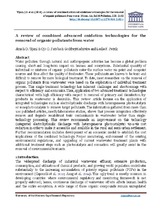| dc.contributor.author | Tijani, Jimoh O. | |
| dc.contributor.author | Fatoba, Ojo O. | |
| dc.contributor.author | Madzivire, Godfrey | |
| dc.contributor.author | Petrik, Leslie | |
| dc.date.accessioned | 2017-12-04T09:44:32Z | |
| dc.date.available | 2017-12-04T09:44:32Z | |
| dc.date.issued | 2014 | |
| dc.identifier.citation | Tijani, J.O. et al. (2014). A review of combined advanced oxidation technologies for the removal of organic pollutants from water. Water, Air, Soil & Pollution, 225: 2102 | en_US |
| dc.identifier.issn | 0049-6979 | |
| dc.identifier.uri | http://dx.doi.org/10.1007/s11270-014-2102-y | |
| dc.identifier.uri | http://hdl.handle.net/10566/3293 | |
| dc.description.abstract | Water pollution through natural and anthropogenic activities has become a global problem causing short-and long-term impact on human and ecosystems. Substantial quantity of individual or mixtures of organic pollutants enter the surface water via point and nonpoint sources and thus affect the quality of freshwater. These pollutants are known to be toxic and difficult to remove by mere biological treatment. To date, most researches on the removal of organic pollutants from wastewater were based on the exploitation of individual treatment process. This single-treatment technology has inherent challenges and shortcomings with respect to efficiency and economics. Thus, application of two advanced treatment technologies characterized with high efficiency with respect to removal of primary and disinfection by-products in wastewater is desirable. This review article focuses on the application of integrated technologies such as electrohydraulic discharge with heterogeneous photocatalysts or sonophotocatalysis to remove target pollutants. The information gathered from more than 100 published articles, mostly laboratories studies, shows that process integration effectively remove and degrade recalcitrant toxic contaminants in wastewater better than single-technology processing. This review recommends an improvement on this technology (integrated electrohydraulic discharge with heterogeneous photocatalysts) viz-a-vis cost reduction in order to make it accessible and available in the rural and semi-urban settlement. Further recommendation includes development of an economic model to establish the cost implications of the combined technology. Proper monitoring, enforcement of the existing environmental regulations, and upgrading of current wastewater treatment plants with additional treatment steps such as photocatalysis and ozonation will greatly assist in the removal of environmental toxicants. | en_US |
| dc.language.iso | en | en_US |
| dc.publisher | Springer Verlag | en_US |
| dc.rights | This is the author-version of the article published online at: http://dx.doi.org/10.1007/s11270-014-2102-y | |
| dc.subject | Degradation | en_US |
| dc.subject | Removal | en_US |
| dc.subject | Organic pollutants | en_US |
| dc.subject | Water | en_US |
| dc.subject | Wastewater | en_US |
| dc.subject | Combined advanced oxidation technologies | en_US |
| dc.title | A review of combined advanced oxidation technologies for the removal of organic pollutants from water | en_US |
| dc.type | Article | en_US |
| dc.privacy.showsubmitter | FALSE | |
| dc.status.ispeerreviewed | TRUE | |

